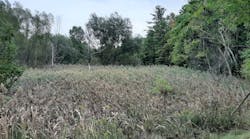
The trees are dying.
We’ve known it for a while; in California’s forests, because of the ongoing drought, trees are dying by the millions. What wasn’t clear was the scale at which it’s happening. The latest aerial survey from the US Forest Service shows that the state has about 102 million dead trees—36 million more than we had in May, at the time of the last survey, and 62 million more than we had at the beginning of this year. Some are dying from lack of water, and others from stressors such as insect infestations that they’re more susceptible to during the drought.
Fewer trees, of course, mean that the areas where they’re dying are more susceptible to erosion. Worse still, the millions of dead trees provide excellent and abundant fuel for wildfires, which, in turn, increase the risk of erosion and mudslides as they destroy living vegetation as well.
Other states that have experienced long-term drought are facing the same situation, and places where a lot of dead fuel is present can expect more frequent and hotter fires. These can be more damaging to the soil, often creating a hard crust “like a sheet of glass,” as one state fire official describes it, that funnels water downhill faster.
Agriculture Secretary Tom Vilsack recently noted, “These dead and dying trees continue to elevate the risk of wildfire, complicate our efforts to respond safely and effectively to fires when they do occur, and pose a host of threats to life and property across California. USDA has made restoration work and the removal of excess fuels a top priority, but until Congress passes a permanent fix to the fire budget, we can’t break this cycle of diverting funds away from restoration work to fight the immediate threat of the large unpredictable fires caused by the fuel buildups themselves.”
Even if the state receives near-normal rainfall this winter, the die-off of trees will continue for a year or two, the Forest Service says. Last year, California set up a task force to help remove fallen and dying trees, and the Forest Service has allocated $43 million to conduct restoration work, mostly along roads and trails where the trees present the greatest hazard to people.
If you’re in a state that is currently or has in the past experienced severe and prolonged drought, what effect did you see on the trees and subsequent fire and erosion risks? What steps have been taken to mitigate the problem?
About the Author
Janice Kaspersen
Janice Kaspersen is the former editor of Erosion Control and Stormwater magazines.

